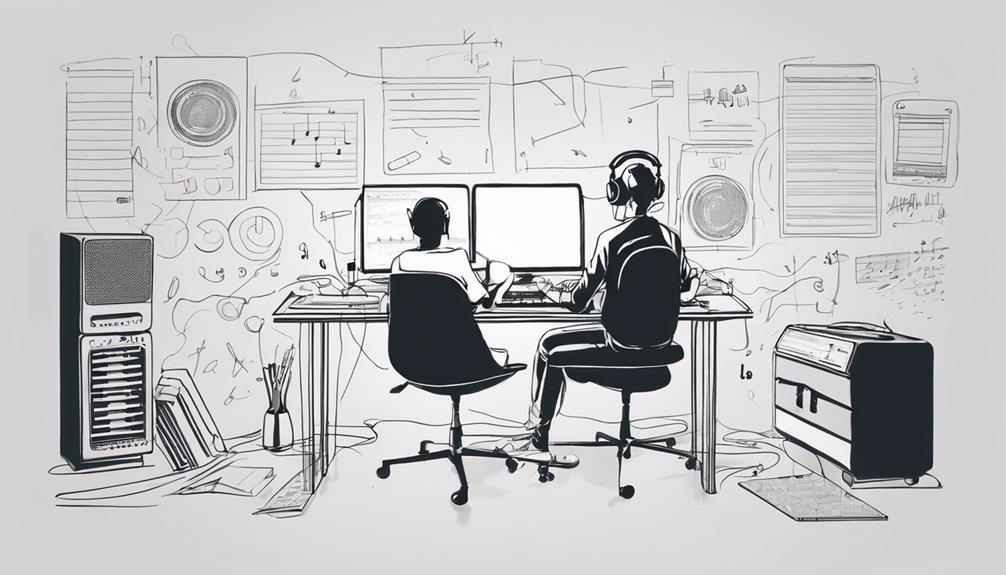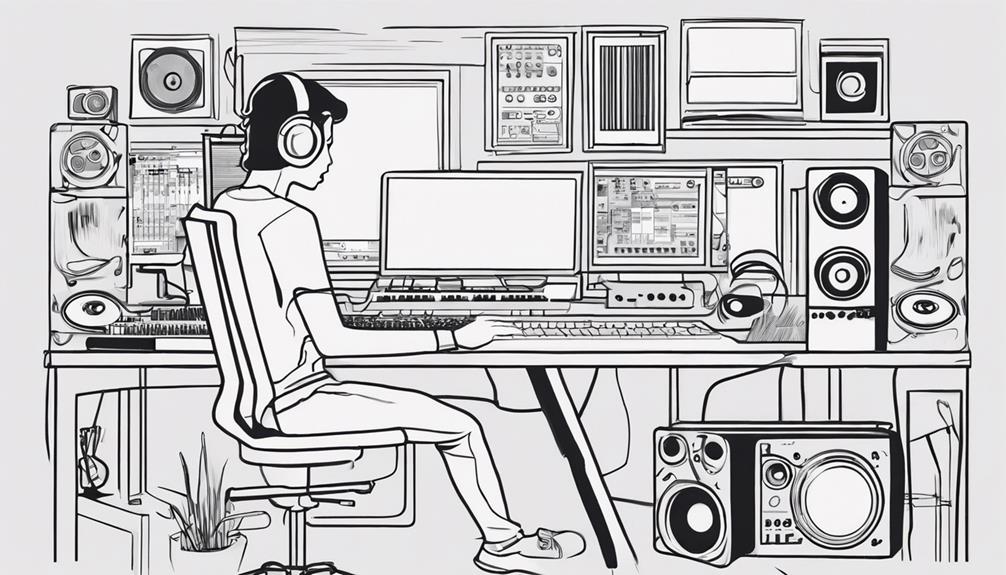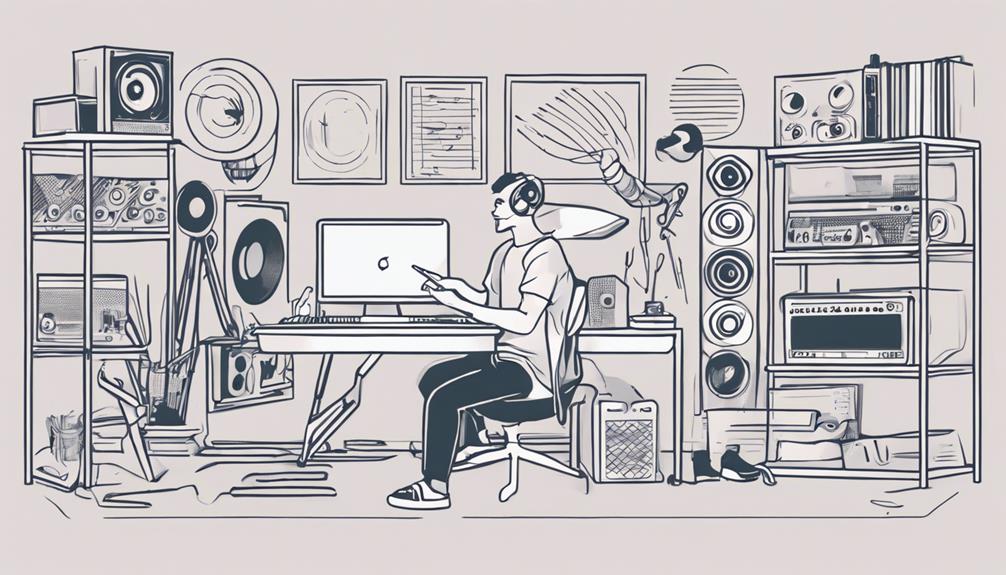Begin your music production journey by shaping your vision with genre, mood, and audience in mind. Structure catchy components like intro, verse, chorus, and bridge. Record vocals and instrumentals using high-quality equipment in a quiet space. Explore your Digital Audio Workstation for editing and arranging. Mix tracks for a polished sound, experiment with effects, and master your final product for a professional touch. Guarantee excellent sound quality by investing in premium equipment and mastering techniques. Once you've polished your creation, release it on the right platform with engaging cover art and a strategic schedule.
Key Takeaways
- Define your genre, mood, and target audience to guide your creative process.
- Structure your song elements logically with intro, verse, chorus, bridge, and outro.
- Record high-quality vocals and instrumentation in a quiet, acoustically treated space.
- Utilize a digital audio workstation (DAW) for recording, editing, and arranging your music.
- Master your final track for a polished, professional sound before releasing it.
Conceptualizing the Vision
Define the genre, mood, and target audience of your music project to shape the vision. Your vision is the guiding light that will drive your creative process.
Consider the emotions you aim to evoke in your listeners and the messages you want to convey through your music. Think about the inspirations that fuel your creativity, whether it's personal experiences, societal issues, or other art forms.
By identifying these key elements, you can create a cohesive and impactful music project that resonates with your audience.
Your vision board should include visual inspirations like album covers, artwork, and mood boards that capture the essence of your project. Collaborate with artists, designers, and creatives who can help bring your vision to life.
Keep a journal or notes to document your ideas, inspirations, and progress as you work towards realizing your musical vision. Stay true to your vision throughout the production process to guarantee a consistent and compelling end result.
Structuring Song Elements
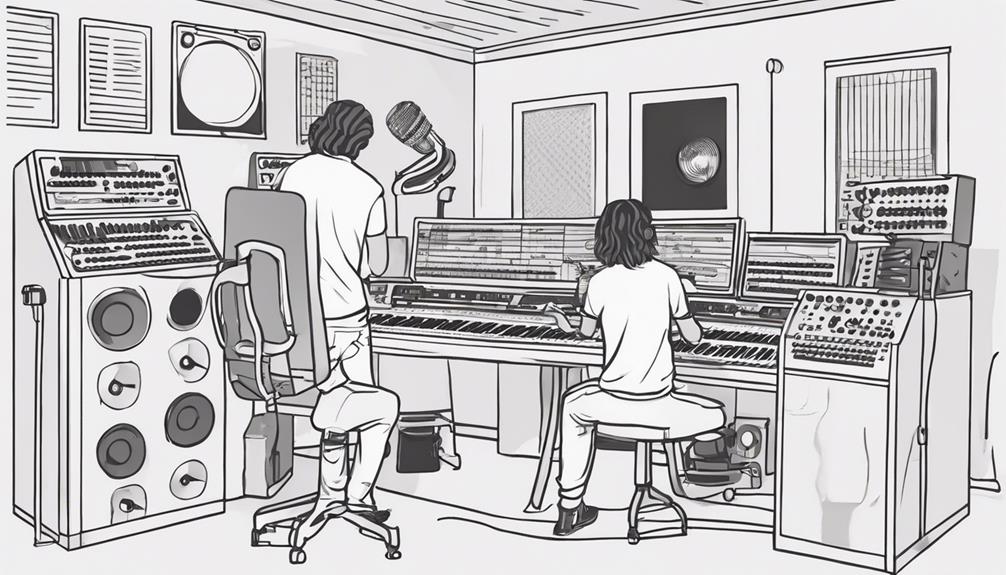
To structure song elements effectively, begin by establishing the basic song components such as intro, verse, chorus, bridge, and outro. These elements form the foundation of your song structure. Arrange them in a logical progression to guide the listener through an engaging musical journey.
Consider the dynamics, instrumentation, and vocal arrangement within each section to add depth and variety to your music.
As you work on structuring your song, think about how to create smooth connections between sections. Experiment with variations in repetition and development to keep the listener engaged and intrigued.
By paying attention to connections, you can maintain a seamless flow throughout the song. This attention to detail ensures that your music evolves cohesively, capturing the listener's interest from start to finish.
Recording Instrumentation and Vocals
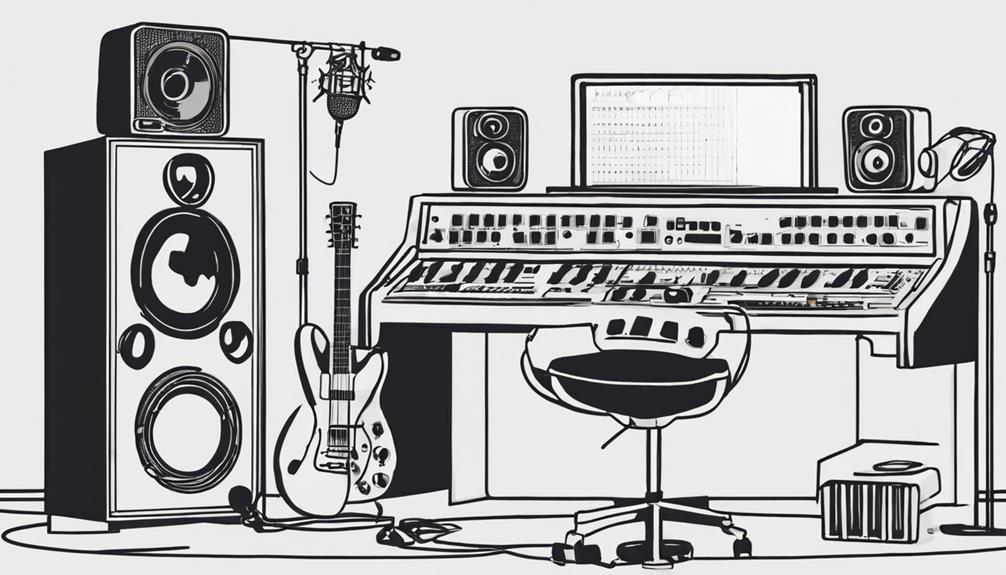
To capture professional-sounding instrumentation and vocals, make sure to use high-quality recording equipment.
Create a conducive environment by setting up a quiet and acoustically treated space.
Experiment with microphone placement and utilize accessories like pop filters for best sound quality.
Setup Recording Equipment
Invest in quality recording equipment, such as an audio interface like the Focusrite Scarlett 2i2, for excellent recording of instruments and vocals. Alongside the audio interface, make sure you have a good pair of headphones like the Sony MDR7506 for accurate monitoring during recording sessions. Set up a microphone, preferably a condenser mic, to capture clear vocals and instrument sounds effectively. Positioning the microphone correctly is essential for capturing the best sound quality from your instruments and vocals. Additionally, ensure your recording environment is acoustically treated to minimize unwanted noise and reflections during recording sessions.
| Equipment | Recommendation |
|---|---|
| Audio Interface | Focusrite Scarlett 2i2 |
| Headphones | Sony MDR7506 |
| Microphone | Condenser Mic |
| Positioning | Proper Mic Placement |
| Environment | Acoustic Treatment |
Capture Quality Performances
To capture quality performances of instrumentation and vocals, make sure you have the right recording equipment and a suitable recording environment. Invest in a quality microphone and audio interface to guarantee clear and crisp sound reproduction. Select a recording space with minimal background noise and good acoustics to prevent unwanted interference in your recordings.
When setting up for a recording session, ensure proper mic placement and adjust levels for best sound quality. Consider using accessories like pop filters, isolation shields, and preamps to enhance the recording process further. Experiment with different microphone techniques to capture unique and creative performances that stand out in your music production.
Utilizing Digital Audio Workstation (DAW)
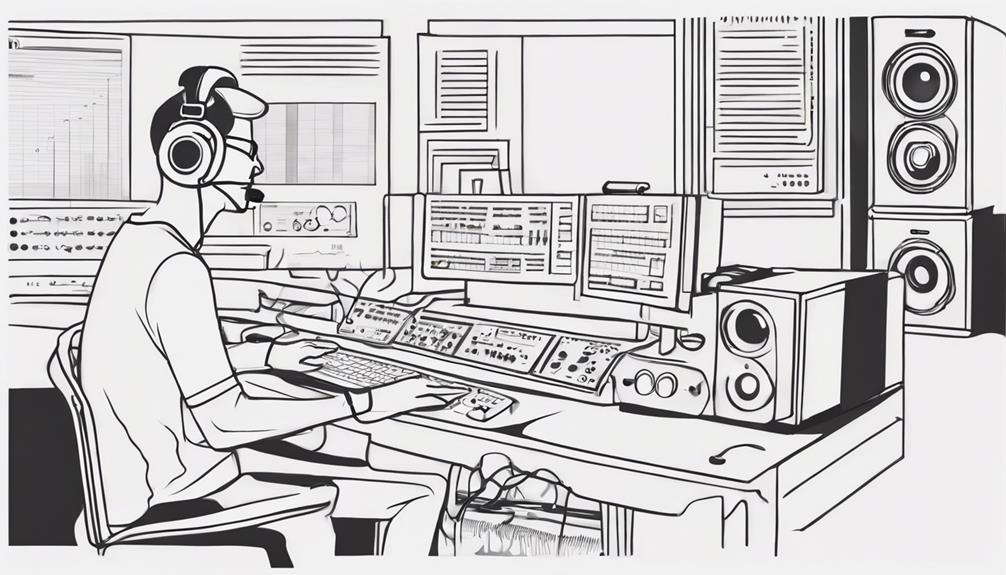
When using a Digital Audio Workstation (DAW), you'll explore the basics and creative tools that shape your music production journey.
DAW basics encompass recording, editing, and arranging tracks, while creative tools like virtual instruments and effects enhance your sound.
Understanding these elements in your chosen DAW will empower you to craft professional-quality music efficiently.
DAW Basics
Utilize a Digital Audio Workstation (DAW) for recording, editing, and producing music efficiently. Learning the essentials of a DAW is vital for your music production journey. While it might seem time-consuming initially, understanding fundamental functions like recording, arranging, and editing within the DAW will streamline your workflow in the long run.
Popular DAWs such as Ableton Live, Logic Pro, FL Studio, and Pro Tools offer a range of features including MIDI editing, virtual instruments, audio effects, and mixing tools. These software tools not only enhance your creative process but also allow seamless integration with hardware controllers, third-party plugins, and virtual instruments.
DAW Creative Tools
Explore the creative tools within your chosen Digital Audio Workstation (DAW) to enhance your music production workflow and tap into your artistic potential. DAWs like Ableton Live, Logic Pro, and FL Studio provide a platform equipped with features such as MIDI sequencing, virtual instruments, and audio editing capabilities. Leveraging these tools can greatly enhance your music production process.
Here's how you can make the most out of your DAW's creative tools:
- Virtual Instruments: Experiment with a wide array of virtual instruments available within your DAW to add unique sounds and textures to your tracks.
- MIDI Sequencing: Utilize MIDI sequencing capabilities to create intricate melodies, harmonies, and rhythms with precision and ease.
- Custom Effects Plugins: Enhance your tracks with custom effects plugins that allow you to sculpt your sound and add depth to your music production.
Arranging and Mixing Tracks
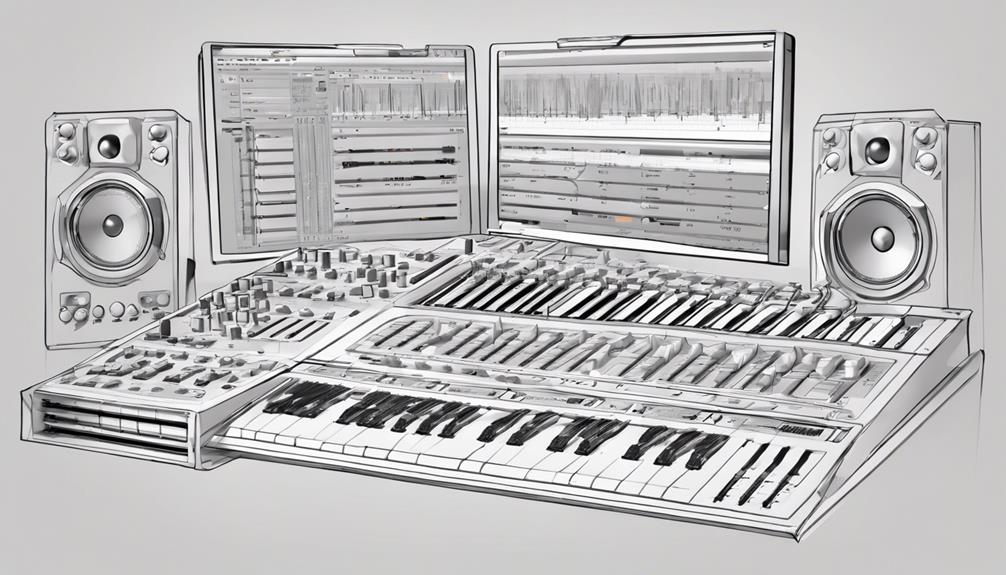
To arrange and mix tracks effectively, focus on organizing different sections and balancing levels to create a cohesive and polished sound. Start by arranging tracks into sections like intro, verse, chorus, bridge, and outro for a structured composition.
When mixing, employ various techniques to balance levels, EQ frequencies, and add effects to enhance the overall quality. Experiment with panning to position instruments within the stereo field, giving each element its own space. Additionally, utilize automation to control parameters such as volume, panning, and effects over time, allowing for dynamic changes in the music.
Attention to detail is vital in mixing; address phase issues, eliminate muddiness, and guarantee clarity in each track element. By incorporating these techniques, you can achieve a well-balanced and professional-sounding mix that highlights the best aspects of your music.
Adding Effects and Adjustments
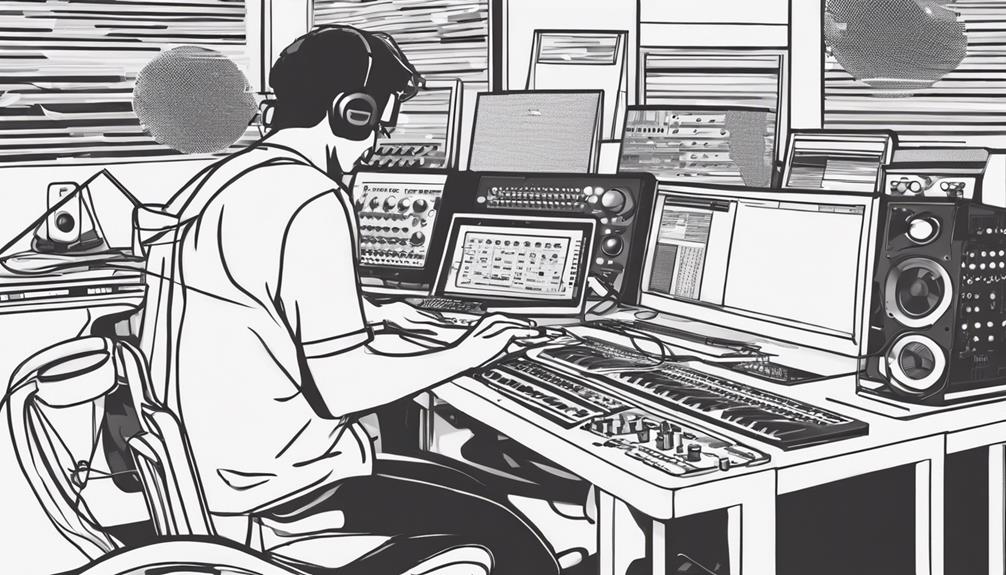
Experiment with various effects like reverb, delay, and distortion to enhance the quality and depth of your sounds. Adjust parameters such as wet/dry mix, decay time, and feedback to fine-tune the effects to your liking.
Utilize automation to create dynamic changes in your effects throughout the track, adding movement and interest. Understand how different effects impact the overall mix, and make adjustments as needed to maintain balance and clarity.
When getting started, using presets can be a helpful way to explore different sounds quickly, but don't be afraid to customize them to suit your track's unique vibe.
Mastering the Final Track
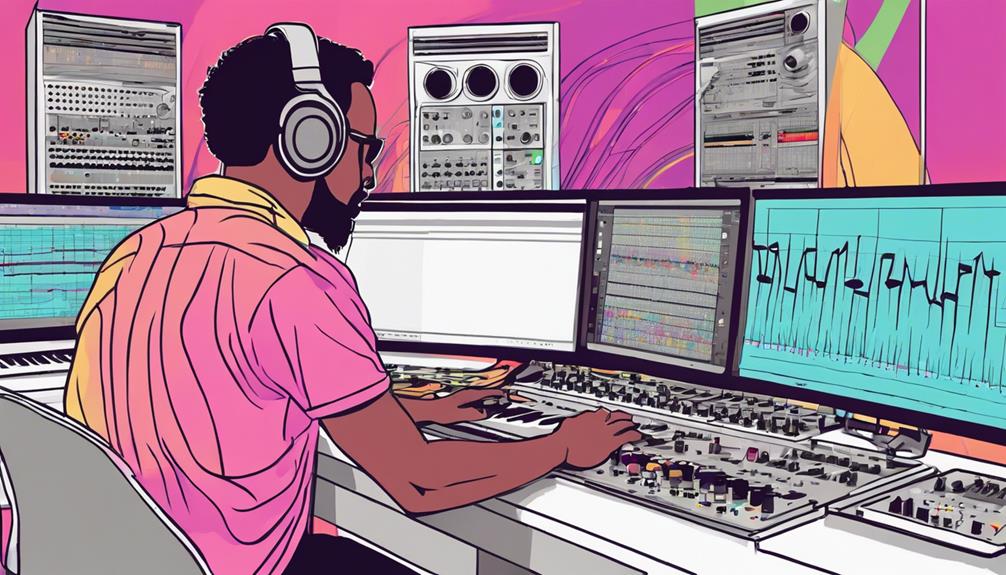
Mastering the final track is an essential step in music production, focusing on enhancing the overall sound quality. During mastering, the final touches are added to guarantee a polished and professional sound for your music.
It involves balancing the different elements of the track, adjusting levels, and using techniques like EQ adjustments, compression, and limiting to achieve the desired sound quality. The goal of mastering is to make sure that your track sounds consistent and cohesive, especially when listened to alongside other tracks in an album or playlist.
Ensuring Polished Sound Quality
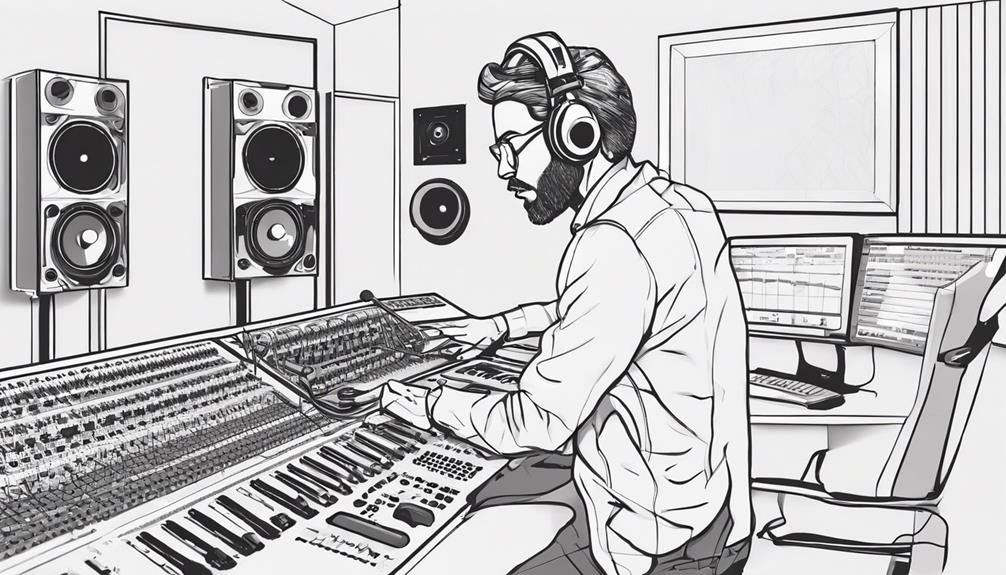
Achieving a polished sound quality in your music production requires utilizing high-quality audio equipment for capturing clear sound. When aiming for a professional sound, consider the following:
- Use Premium Audio Equipment: Invest in top-of-the-line microphones and audio interfaces to guarantee the best sound quality right from the recording stage.
- Implement Essential Mixing and Mastering Techniques: The mixing and mastering process is vital for achieving a balanced and polished sound in your music production.
- Experiment with Effects and Plugins: Enhance the overall quality of your tracks by trying out different effects and plugins to add depth and richness to the sound.
Releasing the Finished Production

Once your music production is polished and ready for release, the next step is to plan how to effectively put it out into the world. Guarantee your tracks are mixed and mastered to achieve professional sound quality that captivates your audience.
Choose the right distribution platform, whether it be streaming services, digital stores, or physical copies, to make your music easily accessible to listeners.
Create visually appealing cover art and engaging promotional materials that reflect the essence of your music and help you stand out in the market.
Develop a strategic release schedule and promotion strategy to generate excitement and reach your target audience effectively.
Engage with your fans through social media, live performances, interviews, and collaborations to build a loyal fan base and expand your music career.
Frequently Asked Questions
How Do I Come up With Music Production Ideas?
To come up with music production ideas, listen to diverse genres, try different instruments, use visuals for inspiration, collaborate with others, and explore MIDI tools. These methods will help spark creativity and generate fresh concepts.
How Do I Start My Own Music Production?
To begin your own music production, immerse yourself in learning music theory, invest in equipment, experiment with genres, explore online resources, and collaborate with others. Embrace the journey of creating music that reflects your unique style and voice. Additionally, as your skills grow, consider monetizing your passion and taking steps to start a music production business. This can involve offering your services to other artists, producing tracks for commercial use, or even selling beats online. By combining creativity with entrepreneurship, you can turn your love for music into a thriving career.
How to Come up With an Idea for a Musical?
To come up with a musical idea, experiment with instruments and melodies, draw inspiration from experiences, collaborate with others, explore various genres, and use visual cues. These methods can spark creativity and help you develop unique concepts for your music.
How to Produce a Song With No Experience?
You can start producing a song with no experience by diving in and experimenting with music production software. Create simple beats, watch tutorials, and practice regularly. Don't shy away from making mistakes – they're part of the learning process!
Conclusion
Now that you've taken your musical idea and turned it into a fully realized production, you've created a masterpiece that's ready to be shared with the world.
Like a sculptor shaping clay into a work of art, you have crafted a musical journey that will captivate and inspire listeners.
Embrace the creative process and let your music shine bright like a diamond in the sky!

